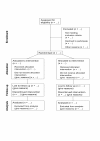Reporting of participant flow diagrams in published reports of randomized trials
- PMID: 22141446
- PMCID: PMC3260171
- DOI: 10.1186/1745-6215-12-253
Reporting of participant flow diagrams in published reports of randomized trials
Abstract
Background: Reporting of the flow of participants through each stage of a randomized trial is essential to assess the generalisability and validity of its results. We assessed the type and completeness of information reported in CONSORT (Consolidated Standards of Reporting Trials) flow diagrams published in current reports of randomized trials.
Methods: A cross sectional review of all primary reports of randomized trials which included a CONSORT flow diagram indexed in PubMed core clinical journals (2009). We assessed the proportion of parallel group trial publications reporting specific items recommended by CONSORT for inclusion in a flow diagram.
Results: Of 469 primary reports of randomized trials, 263 (56%) included a CONSORT flow diagram of which 89% (237/263) were published in a CONSORT endorsing journal. Reports published in CONSORT endorsing journals were more likely to include a flow diagram (62%; 237/380 versus 29%; 26/89). Ninety percent (236/263) of reports which included a flow diagram had a parallel group design, of which 49% (116/236) evaluated drug interventions, 58% (137/236) were multicentre, and 79% (187/236) compared two study groups, with a median sample size of 213 participants. Eighty-one percent (191/236) reported the overall number of participants assessed for eligibility, 71% (168/236) the number excluded prior to randomization and 98% (231/236) the overall number randomized. Reasons for exclusion prior to randomization were more poorly reported. Ninety-four percent (223/236) reported the number of participants allocated to each arm of the trial. However, only 40% (95/236) reported the number who actually received the allocated intervention, 67% (158/236) the number lost to follow up in each arm of the trial, 61% (145/236) whether participants discontinued the intervention during the trial and 54% (128/236) the number included in the main analysis.
Conclusions: Over half of published reports of randomized trials included a diagram showing the flow of participants through the trial. However, information was often missing from published flow diagrams, even in articles published in CONSORT endorsing journals. If important information is not reported it can be difficult and sometimes impossible to know if the conclusions of that trial are justified by the data presented.
Figures
Similar articles
-
Reporting of flow diagrams in randomised controlled trials published in periodontology and implantology: a survey.BMC Med Res Methodol. 2023 Apr 27;23(1):105. doi: 10.1186/s12874-023-01923-7. BMC Med Res Methodol. 2023. PMID: 37106314 Free PMC article.
-
Reporting of CONSORT flow diagrams for parallel group randomized controlled trials published in orthodontic journals.Eur J Orthod. 2025 Apr 8;47(3):cjaf019. doi: 10.1093/ejo/cjaf019. Eur J Orthod. 2025. PMID: 40237386
-
Reporting Quality of Randomized Controlled Trials of Periodontal Diseases in Journal Abstracts-A Cross-sectional Survey and Bibliometric Analysis.J Evid Based Dent Pract. 2018 Jun;18(2):130-141.e22. doi: 10.1016/j.jebdp.2017.08.005. Epub 2017 Sep 21. J Evid Based Dent Pract. 2018. PMID: 29747793
-
Completeness of reporting in randomized controlled trials of 3 vaccines: a review of adherence to the CONSORT checklist.Pediatr Infect Dis J. 2012 Dec;31(12):1286-94. doi: 10.1097/INF.0b013e31827032bb. Pediatr Infect Dis J. 2012. PMID: 22935870 Review.
-
Adherence to CONSORT Guidelines and Reporting of the Determinants of External Validity in Clinical Oncology Randomized Controlled Trials: A Review of Trials Published in Four Major Journals between 2013 and 2015.Curr Oncol. 2023 Feb 8;30(2):2061-2072. doi: 10.3390/curroncol30020160. Curr Oncol. 2023. PMID: 36826121 Free PMC article. Review.
Cited by
-
The effectiveness of Stepping Stones Triple P parenting support in parents of children with borderline to mild intellectual disability and psychosocial problems: a randomized controlled trial.BMC Med. 2014 Oct 28;12:191. doi: 10.1186/s12916-014-0191-5. BMC Med. 2014. PMID: 25348259 Free PMC article. Clinical Trial.
-
A history of the evolution of guidelines for reporting medical research: the long road to the EQUATOR Network.J R Soc Med. 2016 Feb;109(2):67-77. doi: 10.1177/0141076815625599. J R Soc Med. 2016. PMID: 26880653 Free PMC article. No abstract available.
-
Effect of calcitriol supplementation on infectious biomarkers in patients with positive systemic inflammatory response: A Randomized Controlled Trial.Ann Med Surg (Lond). 2024 Jan 3;86(2):875-880. doi: 10.1097/MS9.0000000000001643. eCollection 2024 Feb. Ann Med Surg (Lond). 2024. PMID: 38333320 Free PMC article.
-
The effect of the CONSORT statement on the amount of "unclear" Risk of Bias reporting in Cochrane Systematic Reviews.PLoS One. 2020 Jul 10;15(7):e0235535. doi: 10.1371/journal.pone.0235535. eCollection 2020. PLoS One. 2020. PMID: 32650340 Free PMC article.
-
The effect of presence of family members on the anxiety level of candidates for esophagogastroduodenoscopy: A randomized controlled trial.Med J Islam Repub Iran. 2019 Jun 29;33:62. doi: 10.34171/mjiri.33.62. eCollection 2019. Med J Islam Repub Iran. 2019. PMID: 31456986 Free PMC article.
References
-
- Plint AC, Moher D, Morrison A, Schulz K, Altman DG, Hill C, Gaboury I. Does the CONSORT checklist improve the quality of reports of randomised controlled trials? A systematic review. Med J Aust. 2006;185(5):263–7. - PubMed
Publication types
MeSH terms
LinkOut - more resources
Full Text Sources



